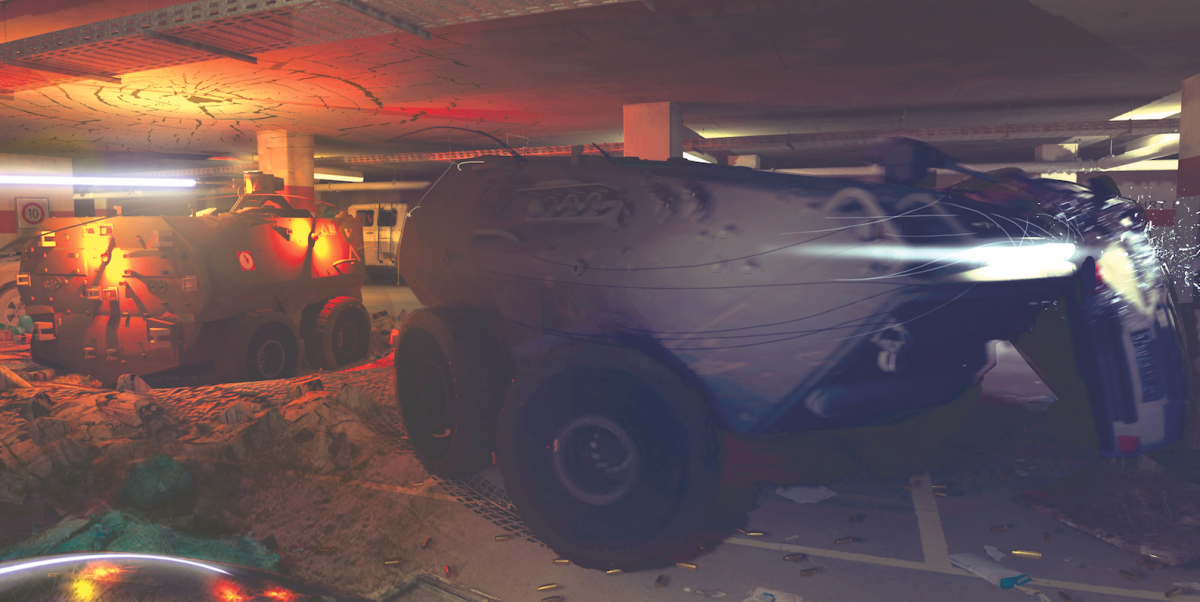
Sticky’s seat began vibrating, a resonant warning from deep inside the British Commonwealth Legion high-speed fighting vehicle, a Marathon HSFV. Then the gunner felt the closing Chinese bot swarm almost in her teeth—as if the sound were coming from her and the crew, not a fast-approaching enemy.
“Move, move, move!” she shouted. The closer the threat, the more her harness tightened, shielding her behind the combat couch’s blast-resistant wings. It felt as if somebody were hammering her coffin lid down while she was paralyzed but still alive. This particular fear was a well-worn track for the 24-year-old private. To suppress the panic, she angrily gloved a salvo of 30 thumb-sized diverters skyward. She quickly followed them with a pair of four-inch pulse-mortar rounds. Those would float gently down on parachutes, shorting out anything electronic within a five-meter radius until they exhausted their batteries. Her haptic suit pinched her to let her know it was overkill for the incoming threat, but it still felt right. She could answer for it when she wasn’t as worried about dying—whenever that day might come.
“Steady all. Shift to position Delta-6,” said Churchill— the Marathon’s commander—in a comfortingly steady voice. The eight-wheeled vehicle crabbed sideways, swaying slightly as it always did when the castering wheels moved it laterally. Down a muddy side street for a few more seconds, then a surge forward as each wheel’s electric motor spooled up.
The 28-year-old driver and mechanic, who went by “C” and was born in Krakow, Poland, had his hands calmly on the controls on either side of him, ready to take over in an instant if need be. C was the team troubleshooter. His physical bulk nearly kept him out of Marathons—he barely fit into the combat couch—but the personnel algorithms kept selecting him for deployment. Churchill and the crew were part of the British Commonwealth Legion’s Third Medium Combat Team. The 3-MCT, an all-Legion unit, was deployed to Djibouti as part of the British Army’s Second Special Purpose Brigade Combat Team.
The hull vibration eased as the artillery-delivered swarm fouled itself on Sticky’s countermeasures. She began to breathe again, looking over at JoJo, 32, a staff sergeant and the onboard integrationist, who nodded his head to a beat nobody else could hear. It was against regulation, but Churchill tolerated JoJo’s powered-up audio implants so long as they only played music stored on the bio-memory woven around his left collarbone. JoJo still liked the Venezuelan hip-hop he grew up with. His eight years in the Commonwealth Legion, testified to by the ivy-like facial tattoos that spread after each deployment, had Churchill thirstily drawing knowledge from him. It was their first deployment in this particular Marathon, 3-D printed on HMS Centurion four months ago on the calm waters of the Persian Gulf.
There was little to say at a moment like this. Talking just got in the way of communication. Everybody on board was acutely attuned to the snaps and cracks, whirs and grinding that passed for a kind of dialogue between human and machine. Their Marathon, with its high-energy laser main gun and a menagerie of small antipersonnel and antiarmor bots, was supposed to occupy a blocking position alongside a joint American and Kenyan armored force. They were four days in, trying to prevent a quasi-civilian Chinese resupply convoy from reaching the People’s Liberation Army infantry and PLA Marines occupying the port district in Djibouti City. But, as often happened, the Marathon had been rerouted mid-mission by an order conjured out of the digital ether and relayed to them by Churchill.
Then the Marathon was falling, before the hull bottomed out and bit concrete. JoJo centralized the view for the three Commonwealth Legion soldiers inside the HSFV’s command capsule: They were now two stories underground in a parking garage beneath a 15-story apartment building, dust motes swirling like snow. To squeeze into the area, the Marathon’s turret folded flat against the rear hull deck and its dynafoam tires softened, allowing the six-ton Marathon to slam its way into a concealed position beside a burned-out panel truck whose side door, spilling out wiring and looted pipes, gaped like a corpse’s mouth. Between its current position and the likely path of approaching infantry was a massive crater, at least ten meters across, caused by a driverless–car bomb of some kind.
Sticky’s right glove tickled, and she saw that she was being prompted to deploy a shield-web. She did so with the flick of her pinkie. A tennis-ball-sized container dropped off the side of the Marathon and split into three disks. They rolled in front of the vehicle before popping open and ejecting a faintly visible tangle of tacky, silvery line. The web stuck to the cracked ceiling and the detritus that covered the floor. The debris—car tires, a refrigerator door, shell casings—was proof of fighting inside the garage not long ago. Like all garages, this one made for a valuable impromptu redoubt. Back and forth the pucks rolled, weaving a nearly invisible web that would inhibit, if not stop, the approaching bots.
“Mate, can you reach Granite Two and Three?” Sticky asked JoJo.
In support of the light Marathons deployed in the port area, two regular British Army tank platoons from the King’s Royal Hussars, a heavy combat team, protected a logistics point near the airport. The Royal Hussars drove heavily evolved Challenger 3 tanks, successors to the 70-ton brutes that were the dominant armored vehicle at the start of the 21st century. In each platoon of four, one tank was conventionally crewed by just two soldiers, while three ran autonomously under low-profile turrets that looked like storks’ beaks.
usni.org